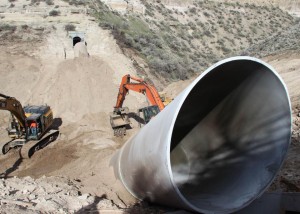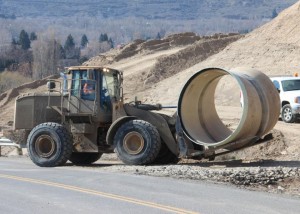By Erin Boudreaux, marketing manager, Hobas Pipe USA
In the United States an irrigation district is a cooperative, self-governing public corporation set up as a subdivision of the State government, with definite geographic boundaries, organized and having taxing power to obtain and distribute water for irrigation of lands within the district. It is created under the authority of a State legislature with the consent of a designated fraction of the landowners or citizens. Washington State Water Resources Association (WSWRA) is the coordinating agency for the irrigation districts in Washington State. It includes 35 irrigation district members covering 1.1 million irrigated agricultural acres. 
Naches-Selah Irrigation District (NSID) encompassing 11,000 acres located in north Yakima County, Wash. It is near the towns of Naches and Selah and it serves over 1,700 landowners. The Naches River is a tributary of the Yakima River in central Washington and it is about 75 miles long. After the convergence of the Little Naches and Bumping River the name becomes the Naches River. The Naches and its tributaries drain a portion of the eastern side of the Cascade Range, east of Mount Rainier and northeast of Mount Adams. In terms of discharge, the Naches River is the largest tributary of the Yakima River.
Selah Valley Canal (NSID’s Main Canal) was put into operation in 1892. As with many older systems, replacement was required as the facilities had passed their useful life and continued maintenance and repairs could not guarantee reliable operation. Also, the manually controlled canal system made it a challenge to operate. Selah Valley Canal includes 8,000 feet of wood flumes which are nine feet in diameter as well as concrete canals. Repairs up to this point have included approaches such as placing plywood sheeting over the leaking wood stave flumes. In other cases, where the flumes collapsed, the time required to fix them could be around two weeks. During the watering season, any disruption could be damaging to the crops.
The 2015 Main Canal Flume Replacement and Other Canal Improvements Project was the most recent phase toward the overall modernization and improvement plan. This project has a cost of around $7 million. Between 1910 to1956 the original materials installed in 1892 were improved to the existing wood and concrete facilities and this new phase is an improvement to them.
Replacement of the wood flume trestles was included in the 1995 Comprehensive Water Conservation Plan and again in the 2007 Modernization Plan. The amount of $9 million in capital improvements was completed during 2005 to 2014. “Improvements included canal lining, replacement of some wooden flumes, replacement of wood pipe and open canals with gravity pressurized pipe networks, modern pressurized farm deliveries and canal automation,” said Justin Harter, district manager, Naches-Selah Irrigation District.
The topography of NSID’s service area provides 200 to 300 feet of fall (available head pressure). Deliveries range from minimal pressure up to 40 to 90 PSI depending on the elevation difference from the canal that flows into the pipe networks. Over 3,000 acres have eliminated their need to pump resulting in a power cost savings.
The replacement of 4,600 feet of wood flumes was completed along with 2,800 feet of canal lined with concrete. The wood flumes were replaced with 3,600 feet of centrifugally cast, fiberglass-reinforced, polymer mortar (CCFRPM) pipe with the remaining footage converted into sections of concrete lined canal. The concrete canal sections include a polyethylene lining that is placed under the reinforced concrete that prevents leakage. Hobas Pipe USA supplied 96-inch diameter CCFRPM pipe with a stiffness class of 36 psi.
“A number of pipe materials were considered. Steel pipe required maintenance of coatings with potential to require coating replacement in 50 years or less to manage corrosion. Although higher in initial costs, non-ferrous pipes provide a lower overall cost with a longer lifespan and less maintenance. Hobas was one of the few pipes that could meet the project schedule and performance criteria,” said Harter. Hobas was not intentionally sole sourced, but the higher specification requirements limited competition.
Tapani, Inc. of Battle Ground, Wash., began construction in November 2014 and was finished before the April 1st season start. There is limited time between October and April when the canal is not flowing. “This project had a very tight schedule to meet in order to supply water to the local farms for the 2015 growing season,” said Aaron Halling, project manager, Tapani, Inc.
There were eight wood trestles from heights of five to 75 feet and draws of 20 to 500 feet wide. In this case, a trestle is a rigid frame used as a support, especially referring to a bridge composed of a number of short spans supported by such frames. Many wooden roller coasters are built using design details similar to trestle bridges.
Other sections of wood flume were on grade, resting on existing soils that were leveled 80 or more years ago. “The 96-inch pipe was installed on grades as steep as 50+% and the existing access roads had to be widened in order to get the pipe to the place of installation. Access was limited and delivering to the further locations with off-road equipment took over a half hour per piece of pipe,” said Halling. 
Wood stave flume trestles were replaced with inverted siphons. The large inverted siphons are used to convey water being carried in canals or flumes across valleys for irrigation. With no pump, they are powered by the fall of the water as it flows down the pipe under the pull of gravity, and discharged at a level lower than the surface of where it originated.
The pipe provided to Tapani included factory assembled FWC couplings. Useful for direct bury applications, the FWC coupling is a structural filament wound sleeve overwrapped and mechanically locked to an internal full-face elastomeric membrane. “We faced challenges, but the project was still an overall success and the pipe performed well,” said Halling.
Hobas manufactures pipe in sizes from 18 inches to 126 inches in pressure and non-pressure classes. For more information, please contact Hobas at 800-856-7473, 281-821-2200 or e-mail at info@hobaspipe.com. Facts are also available at www.hobaspipe.com.
